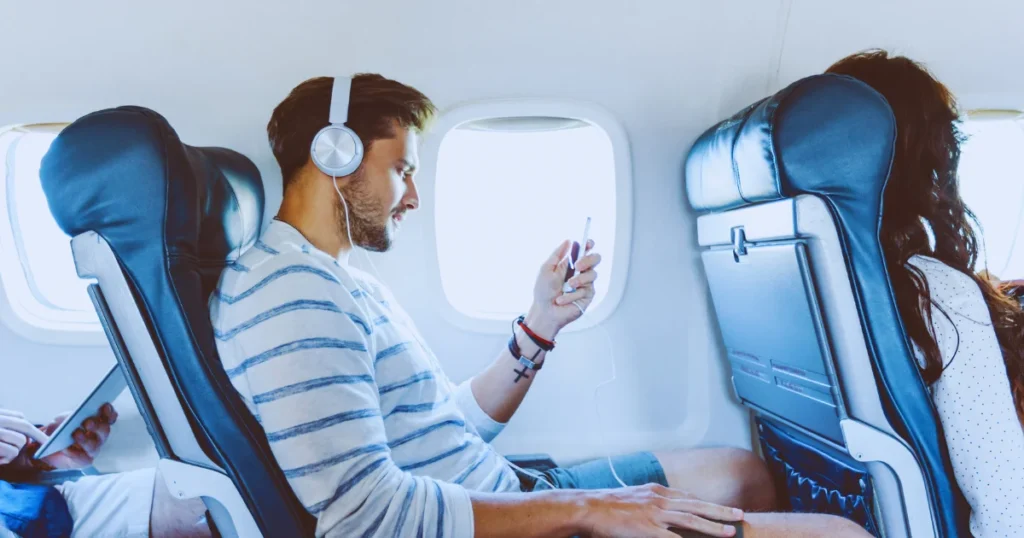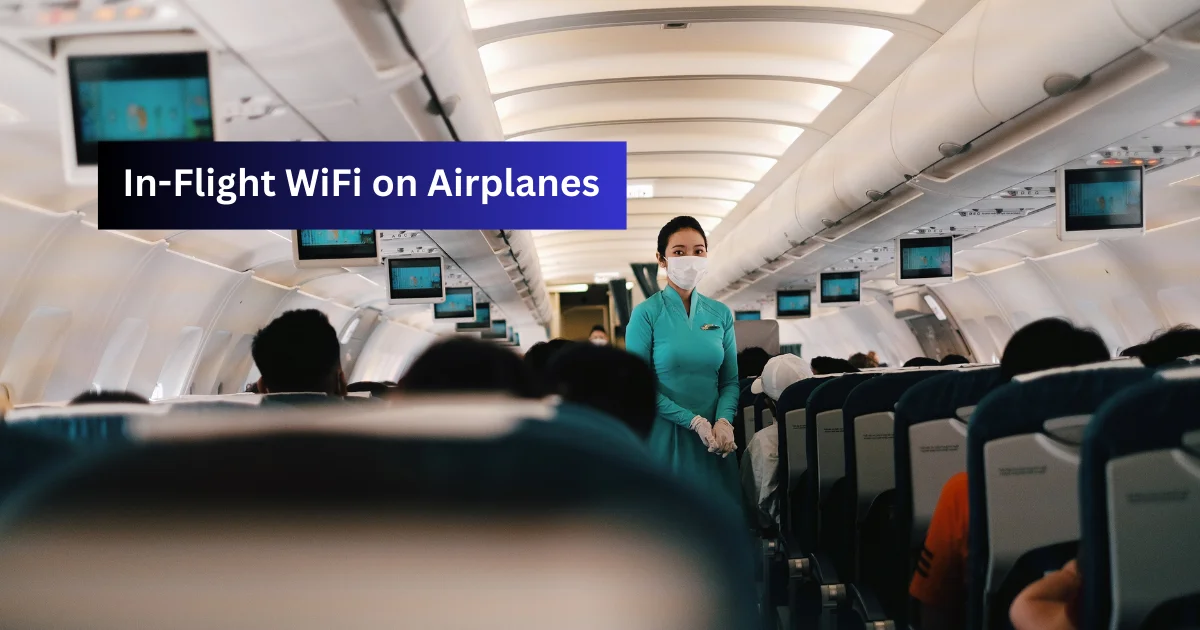Yes, many airplanes today offer Wi-Fi services! Airlines understand that staying connected is important, so they’ve worked hard to bring internet access to passengers at 30,000 feet.
Whether you want to stream movies, catch up on emails, or browse social media, inflight Wi-Fi is available on most major airlines, although the quality and availability of the service may vary depending on the airline, aircraft, and your flight route.
What Is In-Flight WiFi?
In-flight WiFi allows passengers to connect to the internet while flying. It’s like having your favorite coffee shop’s WiFi with you at 30,000 feet!
The functionality can vary, with some airlines offering full internet access and others only allowing messaging apps.
There are primarily two types of in-flight internet services: satellite-based systems, which beam signals from space, and air-to-ground systems which connect to towers on the ground.

The journey of in-flight WiFi has been quite fascinating. It all started in the late 1990s when airlines began experimenting with internet access. Initially, connections were incredibly slow, reminiscent of dial-up speeds.
Over the years, technology has evolved, leading to significant milestones like the introduction of broadband connections. These advancements have made it possible for more passengers to easily access the internet while flying.
How In-Flight WiFi Works
Understanding how in-flight WiFi works requires a bit of technical insight. Airplanes provide Wi-Fi either via satellites or ground-based antennas. In satellite-based systems, the aircraft communicates with satellites orbiting the Earth, which relay the data back to ground stations.
Ground-based systems, on the other hand, use towers located across the country, and as the plane flies, it connects to different towers, much like your phone would connect to cellular towers.
Availability of WiFi on Airlines
Major Airlines Offering WiFi
When it comes to WiFi availability, many major airlines are stepping up their game.
Airlines such as Delta, American Airlines, and United have robust in-flight WiFi offerings.
International carriers like Emirates and Lufthansa also provide reliable internet access.

Interestingly, regional airlines are getting in on the action, albeit at a slower pace.
Global Coverage and Accessibility
The availability of in-flight WiFi can vary greatly by region. While flights over urban areas usually offer solid connectivity, certain places, like remote areas or oceans, may still lack coverage.
Additionally, the type of aircraft can influence WiFi availability, with newer models more likely to have advanced systems onboard.
Pricing Structures for In-Flight WiFi
Pricing for in-flight WiFi varies considerably. Some airlines provide free services, often supported by ads, while others charge passengers, either by session or for the entire flight.
The prices can range from a few dollars to around $30, depending on the airline and the length of the flight.
Plus, some airlines offer subscription services or perks for loyal passengers, which is a nice incentive if you fly frequently.
Quality of In-Flight Internet Connection
Factors Affecting Connection Quality
While the idea of browsing at 30,000 feet sounds amazing, connectivity can be hit or miss. Factors such as the technology used, how many passengers are online, and even weather conditions can affect the speed and reliability of the connection.
It’s not uncommon to experience slow speeds when a flight is packed full of passengers all trying to go online simultaneously.
User Experience: What to Expect
Typically, in-flight WiFi speeds are slower than what you get at home or your favorite café.
Many passengers find that while basic browsing and emailing can work just fine, streaming videos might be challenging or even impossible due to bandwidth limitations.
Still, many use it for quick checks on emails or messaging, making it useful for business and personal use.
As technology progresses, so does in-flight WiFi. Innovations aimed at improving connectivity are constantly being explored.
For instance, airlines are looking into enhancing satellite systems and integrating 5G technology into their services. In the future, we can expect improvements that could bring in-flight internet speeds closer to those we enjoy on the ground.
Security and Safety Concerns
With the convenience of in-flight WiFi comes certain risks. There are potential cybersecurity threats that passengers should be aware of.
Using a virtual private network (VPN) can add a layer of security to your connection. It’s crucial for passengers to understand safe internet practices, like avoiding sensitive transactions while connected to public WiFi.
Safety Regulations Governing WiFi
Safety regulations are also in place regarding in-flight WiFi. The Federal Aviation Administration (FAA) has guidelines that airlines must adhere to ensure passenger safety.
International regulations further ensure that standards are met, creating a safer environment for all onboard.
Airline Protocols for WiFi Use
Airlines typically have protocols for WiFi use to keep everyone safe and informed. Passengers are expected to follow specific rules, such as not using the internet during critical phases of flight.
In case of technical issues, airlines have processes for reporting problems, further maintaining passenger awareness about service security.
Summary
In-flight WiFi is a growing service that enhances the travel experience by connecting passengers to the digital world while at cruising altitude.
Understanding its technology, availability, quality, security, and future trends can help passengers make informed choices about their connectivity needs during flights.

Leave a Reply